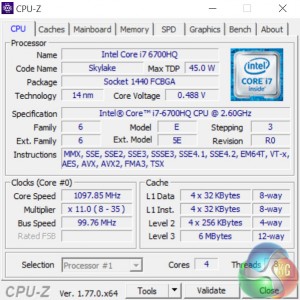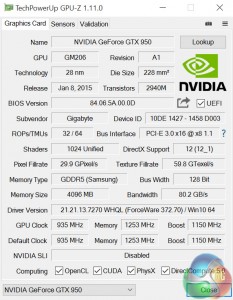Above we can see overviews of the CPU and GPU, courtesy of CPU-Z and GPU-Z respectively.
The i7-6700HQ is a mobile processor I am now very familiar with, having used it in a number of different devices over the past year. It has 4 cores and 8 threads, with a base clock of 2.6GHz. However, its boost clock of 3.5GHz is where it spends most of its time.
The GPU is a 4GB version of the Nvidia GTX 950 – released towards the middle of last year. It is part of the Maxwell family, and we are yet to see a direct successor from the newer Pascal architecture. It has 4GB of GDDR5 memory, with an effective bandwidth of 80.2GB/s over the 128-Bit bus.
While it would be good to see a newer GPU in the BRIX UHD – the GTX 1060 would be very enticing – I can understand the decision to use a GTX 950. It is capable of good frame rates at 1080p, while it draws very little power – many models of the desktop chip draw all their power from the PCIe bus, negating the need for extra cables. This last point is critical, as less power = less heat, something which is important considering the size of the BRIX UHD.
Comparison Systems
Today I will be comparing the BRIX Gaming UHD with the following systems, where applicable.
- Intel Core i7-6700HQ
- Nvidia GTX 960M
- 16GB Dual-Channel 1600MHz DDR3 RAM
- 128GB SSD + 1TB HDD
- Intel Bay Trail-M Celeron N2808 SoC
- Intel HD Graphics
- 4GB DDR3L RAM
- 64GB eMMc storage
- Intel Braswell N3050 SoC
- Intel HD Graphics
- 2GB DDR3L RAM
- 32GB eMMC storage
- Intel Core i3 i3-5010U
- Intel HD Graphics 5500
- 8GB Kingston SODIMM DDR3 1600MHz (1 x 8GB)
- 240GB Kingston V300 SSD
- Intel Core™ m5-6Y57
- Intel HD Graphics 515
- 8GB LPDDR3 1866MHz Memory
- 256GB Solid State Drive M2 2280 PCIe
- Intel Core i5-6500
- Asus Turbo GTX 960
- 8GB Corsair Vengeance LPX 2400MHz DDR4 RAM
- 500GB Samsung 850 EVO SSD
- Intel Core i7-6820HK
- Nvidia GTX 980 (desktop)
- 32GB DDR4 2400MHz RAM
- 2x 256GB Samsung SM951 PCIe SSDs in RAID0
- AMD FX-8320
- AMD RX-480
- 16GB DDR3 2133MHz RAM
- 240GB Adata Premier SP550
PCSpecialist Defiance III 17.3
- Intel i7-6700HQ
- Nvidia GTX 1060
- 16GB HyperX DDR4 2133MHz RAM
- 512GB SanDisk X400 M.2 SATA SSD
And lastly my personal desktop with a Core i3-4160, 8GB 1866MHz DDR3 and a GTX 960.
Test software
- SiSoft Sandra
- Cinebench R15
- Handbrake
- CrystalDiskMark
- ATTO Disk Benchmark
- 3DMark 11
- 3DMark
- Prime 95 (version 26.6)
- CPUID HWMonitor
- AIDA64 Engineer
Test games
- Grid Autosport
- Middle Earth: Shadow of Mordor
- Grand Theft Auto V
- Doom (2016)
All games are tested at 1080p and 4K. While we do not expect anything near playable framerates at 4K, with a name like ‘BRIX Gaming UHD' we simply could not write a review without including 4K benchmarks. All games were tested using the latest (at the time of writing) Nvidia GeForce 372.70 driver.
 KitGuru KitGuru.net – Tech News | Hardware News | Hardware Reviews | IOS | Mobile | Gaming | Graphics Cards
KitGuru KitGuru.net – Tech News | Hardware News | Hardware Reviews | IOS | Mobile | Gaming | Graphics Cards




